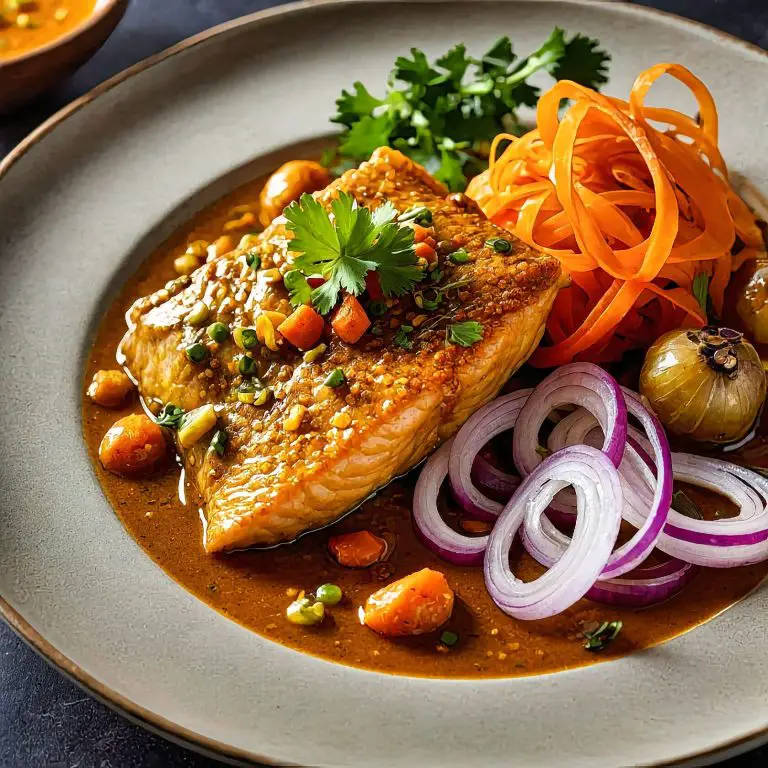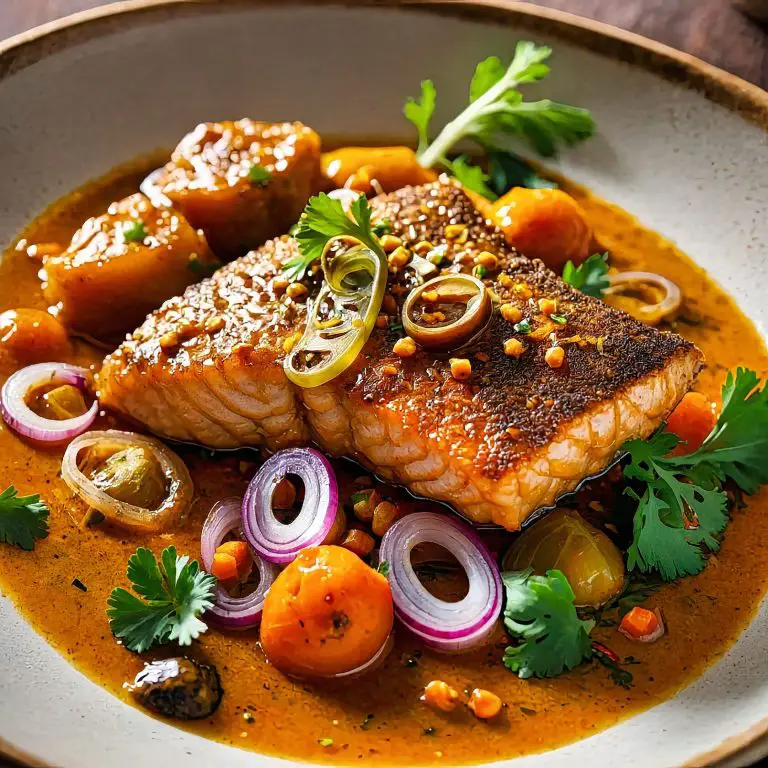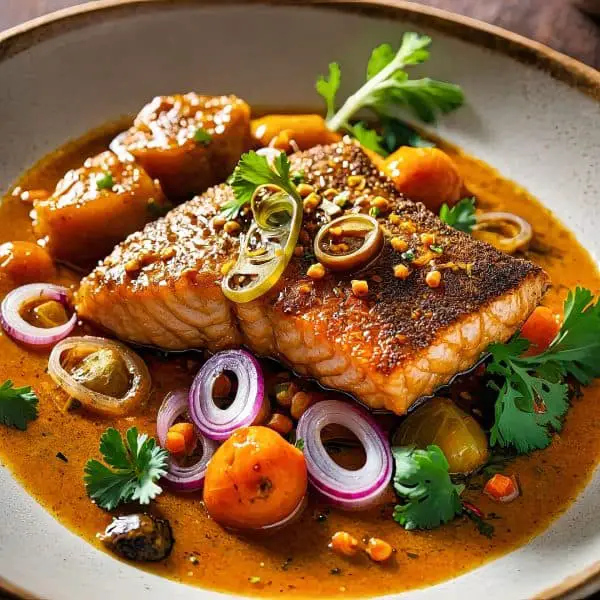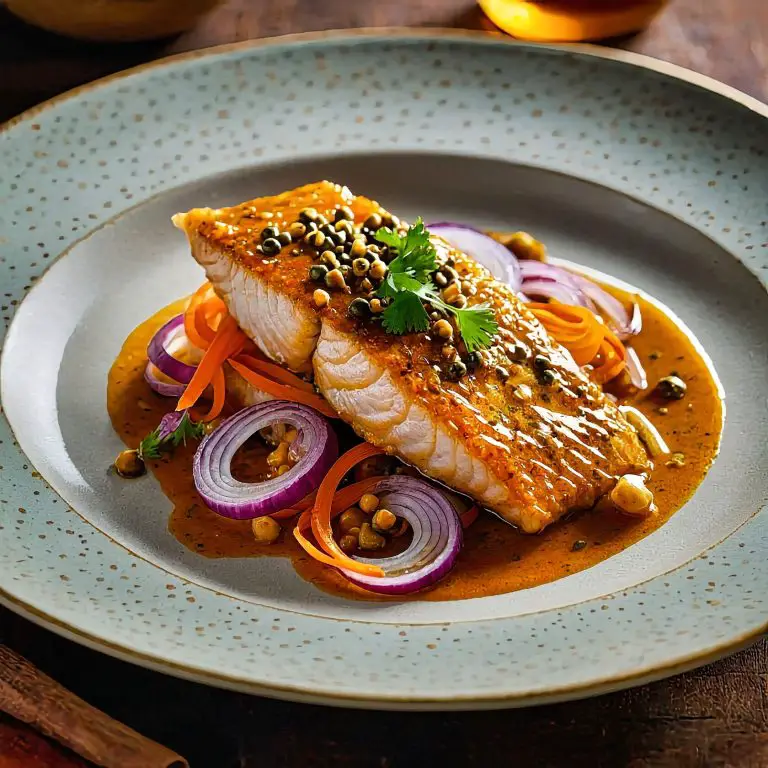South African Pickled Fish Recipe: South African pickled fish is a beloved dish that we often enjoy during festive occasions, especially around Easter. Originating from Cape Town, this recipe reflects our rich culinary culture and combines the flavors of fish with a tangy vinegar marinade.
The unique blend of spices and ingredients makes it a delightful addition to any meal.
As we explore the different variations, we will highlight how simple it can be to prepare this dish in our own kitchens.
The tender texture of the fish, paired with the sharpness of the vinegar, creates a taste that captivates both locals and those new to our cuisine.
Join us as we guide you through an easy step-by-step process to make authentic South African pickled fish. You’ll discover why this classic recipe holds a special place in our hearts and on our tables.

Why You’ll Love This South African Pickled Fish Recipe
We cherish this South African pickled fish recipe for its vibrant and tangy flavor. It brings a unique taste that can elevate any meal.
The combination of spices and vinegar gives the fish a delightful sweetness with a touch of zest. This balance keeps our taste buds excited.
Preparing this dish is straightforward and allows us to explore traditional flavors. Using fresh fish fillets enhances the taste, while pickling ensures the fish stays delicious for a longer time.
Here are some reasons to love this recipe:
- Easy to Make: The cooking steps are simple, making it accessible for all skill levels.
- Versatile: We can enjoy it as a main dish or as a side. It pairs well with salads or bread.
- Health Benefits: Fish is a good source of protein, and the pickling process can add probiotics for gut health.
Sharing this recipe with friends and family adds a touch of culture to our gatherings. We often find that the flavors spark conversations and create lasting memories.
This South African pickled fish recipe is not just food; it’s an experience that brings us together. Each bite is a reminder of the rich culinary heritage we embrace.
What Makes This Recipe Special
South African pickled fish is a unique dish that stands out for several reasons.
First, the balance of flavors is extraordinary. We use a variety of spices, including curry powder, turmeric, and cumin. The mix of spices enhances the fish’s natural taste and gives the dish a rich aroma.
The pickling process is essential. We combine white wine vinegar or white vinegar with spices and sautéed onions. This method not only preserves the fish but also infuses it with a tangy, savory flavor.
Another key element is the use of bay leaves, garlic, and ginger. These ingredients add depth and complexity. The fennel seeds and peppercorns contribute a subtle sweetness and warmth.
We also appreciate the cultural significance of this dish. Traditionally, it is associated with the Cape Malay cuisine, especially during festive celebrations like Easter.
Lastly, serving the fish with crusty bread or red onion pickle enhances the experience. The textures and flavors create a satisfying meal that brings people together.
Our approach to South African pickled fish celebrates both tradition and vibrant flavors, making it a special dish in our culinary repertoire.
Cooking Equipment Needed
To make South African pickled fish, we need some essential cooking equipment. Here’s a list to help us gather everything:
- Large Skillet or Frying Pan: We will use this for frying the fish. A non-stick one makes it easier to cook without sticking.
- Cooking Pot: This is necessary for simmering the pickling liquid. We can use a pot that’s large enough to hold the fish.
- Cutting Board and Knife: We will need these to slice the fish and chop the onions and other ingredients.
- Measuring Cups and Spoons: Accurate measurements are key for the vinegar and spices.
- Wooden Spoon or Spatula: This will help us mix ingredients without damaging our cookware.
- Mixing Bowl: A bowl is needed for combining our ingredients before cooking.
- Serving Dish: Once our fish is ready, we will serve it in a nice dish.
- Storage Container: A glass jar or container is good for keeping the pickled fish. It should have a tight lid to preserve flavors.
For frying, we can choose between vegetable oil or olive oil. Both work well, but olive oil gives a richer flavor.
Having this equipment ready makes the cooking process easier and more enjoyable.

Cooking Instructions
To prepare South African pickled fish, we follow these steps:
- Choose the Fish: We can use firm fish fillets like kingklip, snoek, hake, or mackerel. Ensure the fish is fresh.
- Prepare the Fish: Rinse the fillets and pat them dry. We coat the fish with flour and season it using salt and pepper.
- Fry the Fish: Heat oil in a large skillet. We fry the fish for about 2 minutes on each side until golden brown. Remove the fish from the pan and let it cool.
- Cook the Onions: In the same pan, add sliced brown onions. We fry them gently, stirring regularly until they become soft but do not brown.
- Make the Marinade: In a bowl, we combine vinegar, sugar, bay leaves, and spices such as curry powder. This marinade gives the fish its distinct flavor.
- Combine Ingredients: Layer the fried fish and pickled onions in a jar or dish. We pour the marinade over the fish, ensuring it is well covered.
- Marinate: Cover the dish and let it sit in the fridge for at least 48 hours. This process helps the flavors develop.
- Serve: Enjoy the pickled fish with side dishes like carrots or boiled potatoes. We can also serve it with cod or herring for variety.
Cooking Tips
When making South African pickled fish, we should pay attention to a few essential tips.
Salt and Sugar Balance
Using the right amount of salt and sugar in our pickling liquid is important. These ingredients enhance flavor and help preserve the fish. We recommend a balanced ratio to avoid overpowering the dish.
Refrigerate Marinade
After mixing the pickling marinade, let it cool before adding the fish. This helps to lock in flavors. If we can, let the fish marinate for at least 48 hours for the best taste.
Curry Spice
Adding curry powder creates a distinct flavor that sets this dish apart. We can adjust the amount based on our taste preferences. A little goes a long way, so start small.
Storage
We should store the pickled fish in airtight containers. This keeps the fish fresh and prevents odors from spreading. It’s best to use glass jars to avoid any unwanted tastes.
Pickling Liquid
The pickling liquid should cover the fish completely. This ensures that all parts of the fish absorb the flavors. If needed, we can top it off with a bit more liquid.
Ingredients For the South African Pickled Fish Recipe
Fish Batter
White Fish
Oil
Flour
Eggs, beaten
Salt, to taste
Pepper
Dry Roast Spices
Bay Leaves
Fennel Seeds
Coriander Seeds
Cumin Seeds
Peppercorns
Cloves
Spice Powders
Turmeric
Fish Spice
Paprika
Masala Curry Powder
Salt
Onion Pickle
Onions
Vegetable Oil
White Wine Vinegar
Water
Fresh Chili
Garlic
Ginger
Cooking Instructions For the South African Pickled Fish Recipe
Preparing the Fish
If using frozen fish, ensure it is fully defrosted and at room temperature before starting. Cut the fish into squares or rectangles, roughly 5 cm (2 inches) in size, or about the size of your palm. The goal is to have uniform pieces, but there’s no need to be too precise. Pat the fish dry using a kitchen towel.
Frying the Fish
Use a large pan, as it will be used later for the rest of the cooking. Season the fish with salt, pepper, and fish spice, then coat it in flour and egg. Shake off any excess flour before frying. Heat oil in a non-stick pan and cook the fish until golden brown on both sides. Once done, transfer the fish to a rack or a plate lined with kitchen paper. Set it aside while the spices are toasted—there’s no need to worry about it cooling down, as it will be reheated later.
Toasting the Whole Spices
Place a dry pan or skillet over medium-high heat and add the whole spices. Keep an eye on them, stirring occasionally with a wooden spoon to prevent burning. Within 2 to 3 minutes, the spices will darken, and some may even pop or crackle. Immediately transfer them to a plate to cool, then grind them into a coarse powder.
Sautéing the Aromatics
Using the same pan from frying the fish, lower the heat to medium. Add oil and sauté the garlic, ginger, onions, chili, and all the spices, both whole and powdered. Season with salt and pepper, then add vinegar and water. Reduce the heat to medium-low and let the mixture simmer for 15 minutes.
Cooking the Fish in the Sauce
Carefully return the fried fish to the aromatic onion sauce, spooning the sauce over the pieces to coat them well. Cover and let it simmer for another 10 minutes. If additional liquid is needed, add a cup of half water and half vinegar.
Storage and Serving
Transfer the fish to a non-metallic dish and pour the sauce over it. Let it cool completely before covering with cling wrap. Refrigerate for at least 24 hours, or up to a week, before serving. Garnish with fresh coriander when ready to enjoy.
FAQ For the South African Pickled Fish Recipe
Question: What is a South African Pickled Fish recipe?
A: A South African Pickled Fish recipe is a traditional dish made by marinating fried or lightly cooked fish in a spiced vinegar-based sauce. It typically includes onions, curry powder, turmeric, and bay leaves, creating a tangy and flavorful dish often enjoyed cold.
Question: How long does a South African Pickled Fish recipe need to marinate?
A: A South African Pickled Fish recipe should marinate for at least 24 to 48 hours to allow the flavors to develop fully. Some prefer to let it sit for up to a week for a more intense taste.
Question: What type of fish is best for a South African Pickled Fish recipe?
A: A South African Pickled Fish recipe traditionally uses firm white fish such as hake, kingklip, or snoek. These fish hold their texture well after frying and marinating, preventing them from breaking apart.
Question: Can a South African Pickled Fish recipe be made in advance?
A: Yes, a South African Pickled Fish recipe is best when made in advance, as it needs time to marinate. It can be prepared several days before serving and stored in the refrigerator for up to a week.
Question: How is a South African Pickled Fish recipe traditionally served?
A: A South African Pickled Fish recipe is traditionally served cold, often with fresh bread, buttered rolls, or salad. It is a popular dish during Easter but enjoyed throughout the year in many South African households.

South African Pickled Fish Recipe
Ingredients
Fish Batter
- 2 1/2 lb Fish Cut the fish into pieces around 5cm / 2″ squares or rectangles.
- ⅓ cup Oil sunflower or vegetable oil, use more as needed
- ½ cup Flour
- 4 Eggs beaten
- ½ tsp Salt to taste
- ½ tsp Pepper to taste
Dry Roast Spices
- Bay Leaves stems removed
- Fennel Seeds
- 5 tsp Coriander Seeds
- 1 tsp Cumin Seeds
- 1 tbsp Peppercorns
- 6 Cloves
Spice Powders
- 1 tsp Turmeric
- 1 tsp Fish Spice
- 1 tsp Paprika
- 2 tbsps Masala Curry Powder
- 1 tsp Salt
Onion Pickle
- 16 oz Onions medium size, aproxiamately 4 to 5 onions, sliced
- ¾ cup Vegetable Oil canola oil
- 2 cups White Wine Vinegar approxiamately 500ml
- 1 ½ cups Water
- 1 Fresh Chili de-seeded & sliced, or ½ tsp chili flakes
- 4 cloves Garlic minced
- 1 piece Ginger grated thumb size
Instructions
Preparing the Fish
- If using frozen fish, ensure it is fully defrosted and at room temperature before starting. Cut the fish into squares or rectangles, roughly 5 cm (2 inches) in size, or about the size of your palm. The goal is to have uniform pieces, but there’s no need to be too precise. Pat the fish dry using a kitchen towel.
Frying the Fish
- Use a large pan, as it will be used later for the rest of the cooking. Season the fish with salt, pepper, and fish spice, then coat it in flour and egg. Shake off any excess flour before frying. Heat oil in a non-stick pan and cook the fish until golden brown on both sides. Once done, transfer the fish to a rack or a plate lined with kitchen paper. Set it aside while the spices are toasted—there’s no need to worry about it cooling down, as it will be reheated later.
Toasting the Whole Spices
- Place a dry pan or skillet over medium-high heat and add the whole spices. Keep an eye on them, stirring occasionally with a wooden spoon to prevent burning. Within 2 to 3 minutes, the spices will darken, and some may even pop or crackle. Immediately transfer them to a plate to cool, then grind them into a coarse powder.
Sautéing the Aromatics
- Using the same pan from frying the fish, lower the heat to medium. Add oil and sauté the garlic, ginger, onions, chili, and all the spices, both whole and powdered. Season with salt and pepper, then add vinegar and water. Reduce the heat to medium-low and let the mixture simmer for 15 minutes.
- Cooking the Fish in the Sauce
- Carefully return the fried fish to the aromatic onion sauce, spooning the sauce over the pieces to coat them well. Cover and let it simmer for another 10 minutes. If additional liquid is needed, add a cup of half water and half vinegar.
Storage and Serving
- Transfer the fish to a non-metallic dish and pour the sauce over it. Let it cool completely before covering with cling wrap. Refrigerate for at least 24 hours, or up to a week, before serving. Garnish with fresh coriander when ready to enjoy.



4 comments
I made South African Pickled Fish for the first time, and it was a great success! The fish was tender and packed with flavor from the tangy vinegar and spices. My guests loved the unique combination of sweet and sour. It paired wonderfully with bread or crackers. I’ll definitely be making this again for future gatherings!
Im not sure about this South African Pickled Fish Recipe. Is it really worth all the effort and unique ingredients? Im intrigued, but also a bit skeptical. What do you guys think?
I find it intriguing how this South African Pickled Fish Recipe is described as special. I wonder if the unique combination of flavors truly sets it apart from other pickled fish recipes. I might just have to try it out to see for myself!
Im not so sure about this South African Pickled Fish Recipe. I mean, pickled fish? Sounds like a strange combo to me. Anyone else feeling skeptical about trying this out?